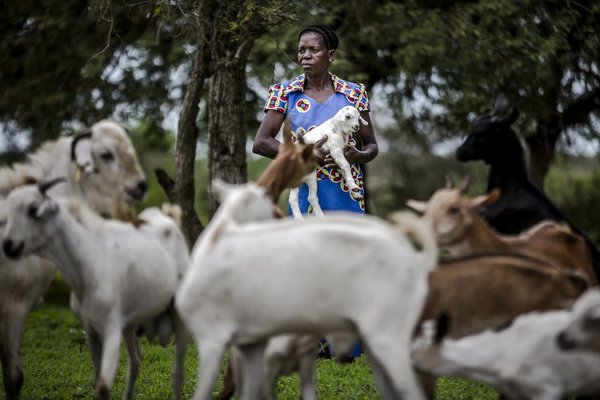 Read this article in French
Read this article in French- Share this article
- Subscribe to our newsletter
Progress in fighting Peste des petits ruminants
Globally, the number of outbreaks of Peste des petits ruminants (PPR), also known as sheep and goat plague, fell by two-thirds in recent years, the Food and Agriculture Organization of the United Nations (FAO) reported in January 2021. Just over 1,200 global PPR outbreaks were recorded in 2019 (latest data available), compared to more than 3,500 in 2015.
This progress raises hopes for meeting the goal of global PPR eradication by 2030 that was set in 2015 by the international community. Since then, FAO and the World Organisation for Animal Health (OIE) have developed and implemented a Global PPR Control and Eradication Strategy.
PPR can be deadly for animals - with a 30-70 per cent fatality rate - but it does not infect people. That said, PPR has major effects on people due to its severe impact on food security, community resilience and livelihoods.
Vaccination campaigns show success
The decrease in PPR outbreaks is attributed to the impact of vaccination campaigns in more than 50 countries. The campaigns were led and funded by countries with support from FAO and partners. In just 12 of these countries, over 300 million goats and sheep were vaccinated between 2015 and 2018.
Vaccination is essential for PPR prevention and control based on experience from the successful global eradication of rinderpest in 2011 by FAO, OIE and their partners, and the availability of effective PPR vaccines. FAO and OIE recommend that PPR vaccination should be rolled out during two successive years, followed by vaccination of newborn animals during one or two successive years.
Two regions have been the worst hit by PPR and reported the majority of outbreaks between 2015-2019 - Asia over 75 per cent and Africa over 24 per cent, although the disease may also be underreported. Nearly half of all outbreaks in this period occurred in only five countries, highlighting the urgent need for strengthening prevention and control mechanisms.
Vaccinating 1.5 billion small ruminants by the end of 2021
The PPR vaccine stock/bank established by FAO, OIE, and other partners have improved the quality assurance and supply of vaccines. However, to achieve PPR eradication, the funding gap for vaccination campaigns and other programme activities must be filled.
The first phase of the global PPR programme set a target of vaccinating 1.5 billion small ruminants by the end of 2021. As of mid-2020, around half of this target had been achieved, with the COVID-19 pandemic having significantly disrupted animal health services including PPR vaccinations and outbreak reporting last year. These disruptions continue in 2021 as the world is still grappling with the pandemic.
FAO also stresses the need for prevention and control measures to be coordinated between neighbouring countries to restrict transboundary movement of disease. Strengthening surveillance and post-vaccination sero-monitoring at country level is also essential.
The funding gap for the PPR Global Eradication Program is estimated at USD 340 million. Challenges, both financial and logistical, remain. However, the latest data show progress, reflecting the commitment of countries and FAO, OIE to eradicate PPR, and give cause for optimism. The second phase (2022-2027) of the programme will be formulated in 2021.
(FAO/ile)
Read more at FAO website





Add a comment
Be the First to Comment